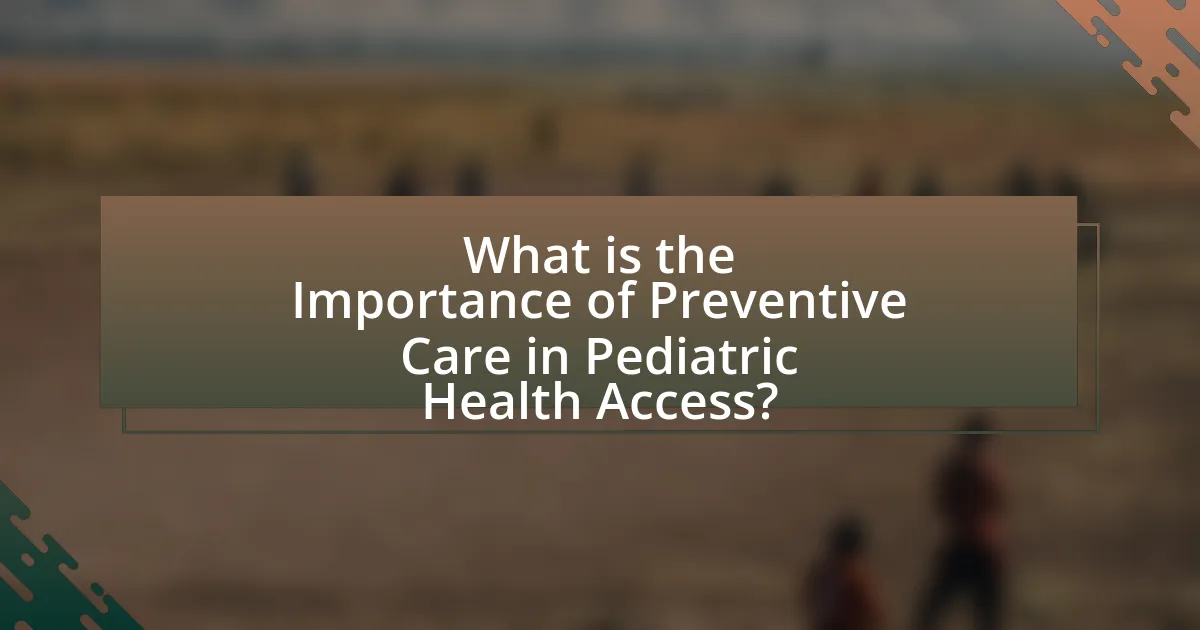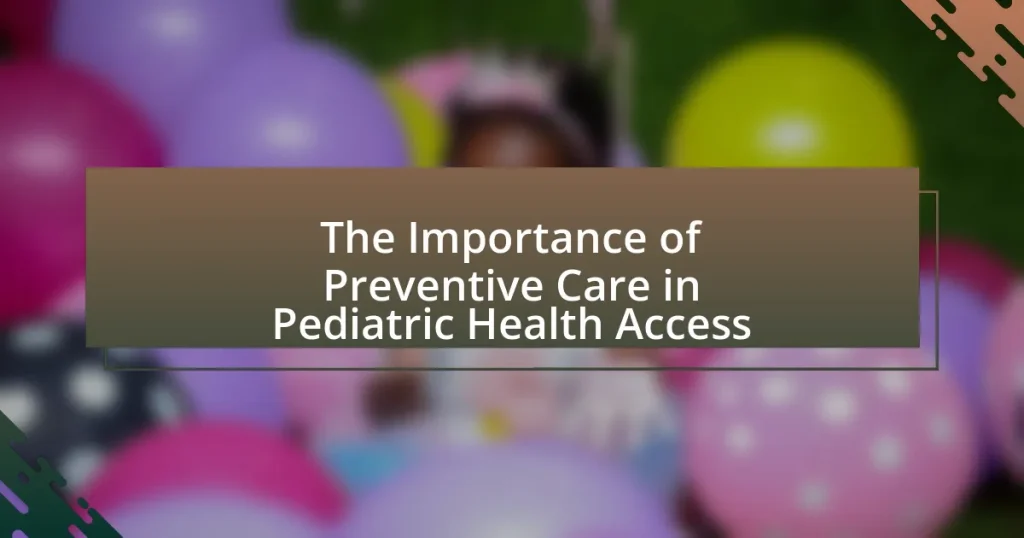Preventive care is a critical component of pediatric health access, significantly reducing the incidence of serious health issues in children through early detection and intervention. Key elements of preventive care include regular health screenings, vaccinations, developmental assessments, and health education, all of which contribute to healthier outcomes and lower healthcare costs. Access to preventive care is influenced by socioeconomic factors, with barriers such as lack of insurance and transportation affecting utilization rates. Community programs and school-based initiatives play vital roles in enhancing access and promoting preventive health measures, ultimately improving long-term health outcomes for children.

What is the Importance of Preventive Care in Pediatric Health Access?
Preventive care is crucial in pediatric health access as it significantly reduces the incidence of serious health issues in children. By focusing on early detection and intervention, preventive care helps identify potential health problems before they develop into more severe conditions. For instance, regular check-ups and vaccinations can prevent diseases such as measles and whooping cough, which have seen resurgence in populations with low vaccination rates. According to the Centers for Disease Control and Prevention (CDC), childhood vaccinations prevented an estimated 21 million hospitalizations and 732,000 deaths among children born in the last two decades. This underscores the importance of preventive care in ensuring healthier outcomes and reducing healthcare costs in the long run.
Why is preventive care crucial for children’s health?
Preventive care is crucial for children’s health because it helps identify and address health issues before they become serious. Regular check-ups, vaccinations, and screenings can detect conditions like obesity, diabetes, and developmental delays early, allowing for timely interventions. According to the Centers for Disease Control and Prevention (CDC), immunizations alone prevent an estimated 21 million hospitalizations and 732,000 deaths among children in the United States each year. This proactive approach not only enhances children’s immediate health but also establishes a foundation for lifelong wellness.
What are the key components of preventive care in pediatrics?
The key components of preventive care in pediatrics include regular health screenings, immunizations, developmental assessments, and health education. Regular health screenings, such as vision and hearing tests, help identify potential issues early, allowing for timely intervention. Immunizations protect children from various infectious diseases, with the CDC recommending a schedule that includes vaccines for measles, mumps, rubella, and more. Developmental assessments monitor milestones in physical, emotional, and social growth, ensuring children are on track. Health education provides families with information on nutrition, physical activity, and safety, promoting overall well-being. These components collectively contribute to reducing morbidity and mortality rates in children, as evidenced by studies showing that immunization programs significantly decrease disease incidence.
How does preventive care impact long-term health outcomes for children?
Preventive care significantly improves long-term health outcomes for children by reducing the incidence of chronic diseases and promoting healthy development. Regular check-ups, vaccinations, and screenings help identify health issues early, allowing for timely interventions that can prevent complications. For instance, the Centers for Disease Control and Prevention (CDC) reports that childhood vaccinations have led to a 99% reduction in diseases like measles and polio, which can have lasting health impacts if contracted. Additionally, preventive care fosters healthy behaviors, such as proper nutrition and physical activity, which are crucial for long-term wellness. Studies indicate that children who receive consistent preventive care are more likely to maintain better health into adulthood, reducing healthcare costs and improving quality of life.
What role does access to preventive care play in pediatric health?
Access to preventive care is crucial in pediatric health as it facilitates early detection and management of health issues, thereby reducing the risk of severe illnesses. Preventive care services, such as vaccinations, regular check-ups, and screenings, help monitor children’s growth and development, ensuring timely interventions. According to the Centers for Disease Control and Prevention (CDC), immunization prevents an estimated 21 million hospitalizations and 732,000 deaths among children in the United States each year. This underscores the significant impact of preventive care on improving health outcomes and enhancing the overall well-being of children.
How does socioeconomic status affect access to preventive care?
Socioeconomic status significantly affects access to preventive care by creating barriers related to financial resources, education, and healthcare availability. Individuals with lower socioeconomic status often face challenges such as inadequate health insurance, limited transportation options, and a lack of awareness about preventive services. For instance, a study published in the American Journal of Public Health found that low-income families are less likely to utilize preventive services like vaccinations and screenings due to cost and accessibility issues. This disparity in access can lead to poorer health outcomes and increased healthcare costs over time, highlighting the critical need for targeted interventions to improve access for disadvantaged populations.
What barriers exist that limit access to preventive care for children?
Barriers that limit access to preventive care for children include socioeconomic factors, lack of insurance, transportation issues, and limited availability of healthcare providers. Socioeconomic factors, such as low income, can restrict families from affording preventive services, as evidenced by a study from the American Academy of Pediatrics, which found that children from low-income families are less likely to receive timely vaccinations. Lack of insurance further exacerbates this issue, with uninsured children being significantly less likely to access preventive care. Transportation issues also play a critical role; families without reliable transportation may struggle to attend appointments, as highlighted by research from the National Center for Children in Poverty. Additionally, in many rural areas, there is a shortage of healthcare providers, making it difficult for families to access necessary preventive services.
How can preventive care improve overall pediatric health systems?
Preventive care can significantly improve overall pediatric health systems by reducing the incidence of chronic diseases and promoting early detection of health issues. By implementing regular screenings, vaccinations, and health education, pediatric health systems can identify and address potential health problems before they escalate, leading to better health outcomes. For instance, the Centers for Disease Control and Prevention (CDC) reports that childhood vaccinations prevent an estimated 21 million hospitalizations and 732,000 deaths among children born in the last two decades. This proactive approach not only enhances individual health but also decreases healthcare costs and resource utilization, ultimately strengthening the pediatric health system as a whole.
What are the benefits of integrating preventive care into pediatric practices?
Integrating preventive care into pediatric practices enhances child health outcomes by promoting early detection and management of health issues. This proactive approach reduces the incidence of chronic diseases, as studies indicate that regular check-ups and vaccinations significantly lower hospitalization rates and healthcare costs. For instance, the American Academy of Pediatrics reports that children receiving preventive care are less likely to develop conditions such as obesity and asthma, leading to improved long-term health trajectories. Additionally, preventive care fosters stronger relationships between healthcare providers and families, encouraging adherence to health recommendations and improving overall community health.
How does preventive care reduce healthcare costs in the long run?
Preventive care reduces healthcare costs in the long run by decreasing the incidence of chronic diseases and minimizing the need for expensive treatments. By focusing on early detection and management of health issues, preventive care can lead to significant savings; for instance, the Centers for Disease Control and Prevention (CDC) estimates that every dollar spent on childhood vaccinations saves approximately $3 in direct healthcare costs and about $10 in additional societal costs. This proactive approach not only improves health outcomes but also alleviates the financial burden on healthcare systems by reducing hospitalizations and emergency care needs associated with untreated conditions.
What strategies can enhance access to preventive care for children?
Enhancing access to preventive care for children can be achieved through strategies such as increasing community outreach programs, improving transportation options, and integrating preventive services into schools. Community outreach programs, like mobile health clinics, have been shown to increase service utilization by 30% among underserved populations. Improving transportation options, such as providing free or subsidized transport to healthcare facilities, addresses barriers that families face in accessing care. Additionally, integrating preventive services into schools allows for easier access to vaccinations and health screenings, reaching children where they spend a significant portion of their time. These strategies collectively contribute to improved health outcomes and increased utilization of preventive care services among children.
How can community programs support preventive care initiatives?
Community programs can support preventive care initiatives by providing accessible health education, resources, and services tailored to local populations. These programs often facilitate workshops and outreach activities that inform families about preventive measures, such as vaccinations and healthy lifestyle choices, which are crucial for pediatric health. For instance, a study published in the American Journal of Public Health found that community-based interventions significantly increased vaccination rates among children in underserved areas. By fostering partnerships with local healthcare providers, community programs can also enhance access to screenings and preventive services, ensuring that children receive timely care that can prevent future health issues.
What role do schools play in promoting preventive health measures?
Schools play a crucial role in promoting preventive health measures by providing education, resources, and access to health services for students. They implement health education programs that teach children about nutrition, physical activity, hygiene, and mental health, which are essential for fostering healthy habits. For instance, the Centers for Disease Control and Prevention (CDC) emphasizes that school-based health education can significantly reduce risky behaviors among adolescents, leading to improved health outcomes. Additionally, schools often collaborate with healthcare providers to offer screenings, vaccinations, and wellness programs, ensuring that students receive necessary preventive care. This multifaceted approach not only enhances individual student health but also contributes to the overall well-being of the community.
What are best practices for implementing preventive care in pediatric health?
Best practices for implementing preventive care in pediatric health include regular health screenings, vaccinations, and parental education. Regular health screenings, such as developmental assessments and vision checks, help identify potential health issues early, allowing for timely intervention. Vaccinations are crucial in preventing infectious diseases; for instance, the CDC recommends a series of vaccines during childhood to protect against diseases like measles and whooping cough. Parental education on nutrition, physical activity, and mental health promotes healthy lifestyle choices, which are essential for long-term well-being. Studies show that children receiving preventive care have better health outcomes, including reduced hospitalizations and improved quality of life.
How can healthcare providers effectively communicate the importance of preventive care to families?
Healthcare providers can effectively communicate the importance of preventive care to families by using clear, relatable language and providing specific examples of health outcomes associated with preventive measures. For instance, discussing how vaccinations can prevent serious diseases like measles or how regular check-ups can lead to early detection of health issues reinforces the value of preventive care. Research indicates that families are more likely to engage in preventive care when they understand its direct benefits, such as reduced hospital visits and improved long-term health outcomes. A study published in the Journal of Pediatrics found that families who received tailored educational materials about preventive care were 30% more likely to adhere to recommended health screenings and vaccinations.
What resources are available for families to access preventive care services?
Families can access preventive care services through various resources, including community health centers, public health programs, and insurance coverage options. Community health centers provide comprehensive services regardless of insurance status, often offering sliding scale fees based on income. Public health programs, such as the Vaccines for Children program, ensure that children receive necessary vaccinations at no cost to families who qualify. Additionally, many insurance plans cover preventive services without copays, as mandated by the Affordable Care Act, which includes routine check-ups, screenings, and immunizations. These resources collectively enhance access to essential preventive care for families, promoting better health outcomes for children.
